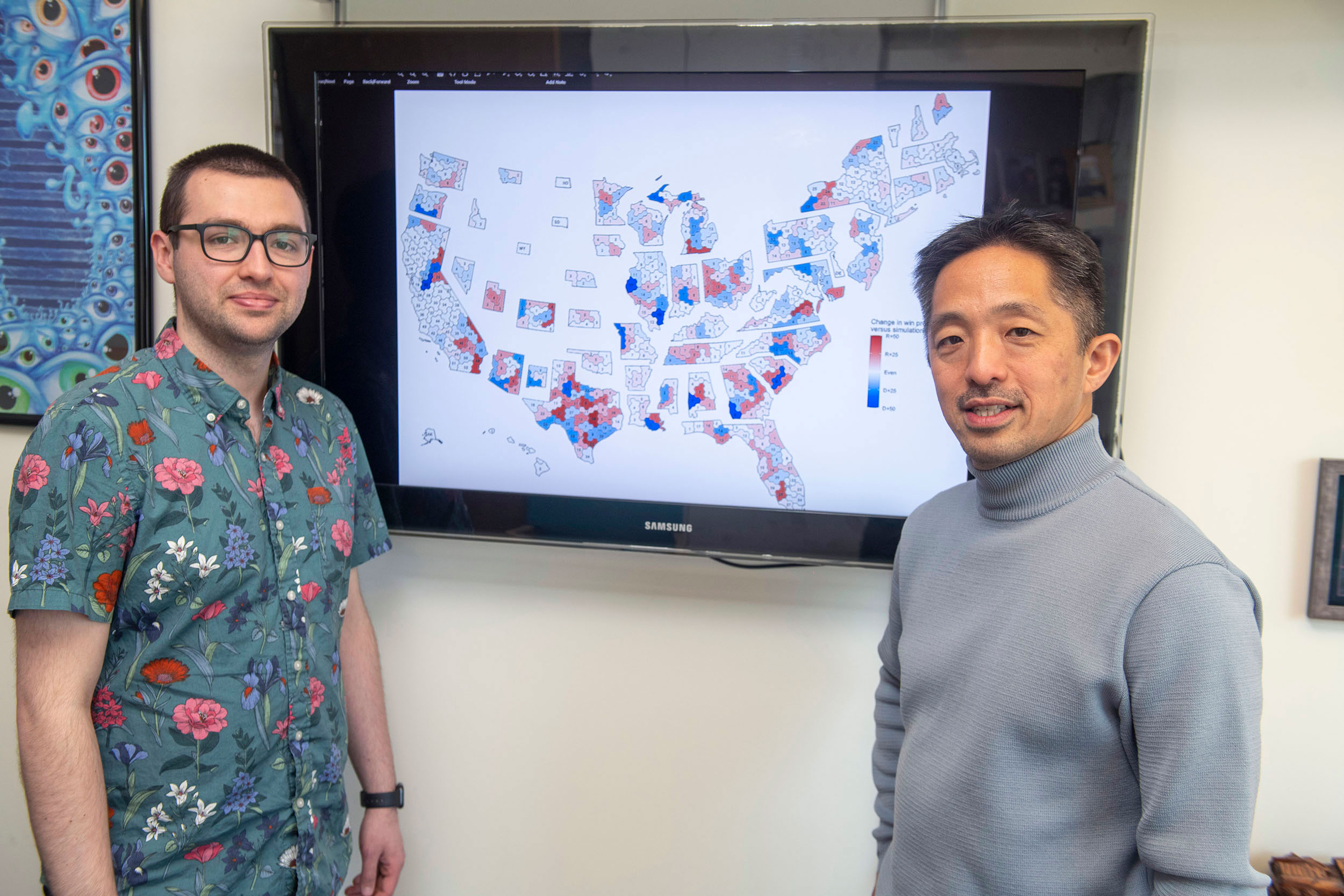Biggest problem with gerrymandering

“A lot of voters are living in systems that are less responsive to their needs than we would expect,” summarized lead author Christopher T. Kenny (left) with Kosuke Imai, professor of government and of statistics.
Jon Chase/Harvard Staff Photographer
Researchers found tactic, widely used in 2020, made little difference in partisan numbers but yielded safe seats, less-responsive representatives
Harvard researchers say gerrymandering is still a problem, but for perhaps less-obvious reasons.
They found the tactic used by parties to gain a numerical advantage in Congress was widespread during the 2020 redistricting cycle, yet its effect on the partisan makeup of the U.S. House of Representatives was small. Their in-depth analysis, published last month in the Proceedings of the National Academy of Sciences, found the country’s patchwork of congressional districts netted Republicans all of two House seats.
Still, the researchers hold that gerrymandering harms our democracy. “Elections are a way to hold politicians accountable for what their constituency wants,” said Kosuke Imai, professor of government and of statistics as well as leader of the ALARM Project research team, which uses big data and computational algorithms to study redistricting. “But if many lawmakers are in safe seats, guaranteed to win by a relatively comfortable margin, there’s less incentive to respond to what voters want.”
In other words, gerrymandering does not starkly tip the balance of power nationally, but it does disempower Americans at the district level. “A lot of voters are living in systems that are less responsive to their needs than we would expect,” summarized lead author Christopher T. Kenny, an ALARM researcher and a Ph.D. candidate in government in the Griffin Graduate School of Arts and Sciences.
With this study, the ALARM team set out to scrutinize redistricting in 2020 — a rebalancing of seats done once a decade when new census data becomes available — with the help of its open-source software package, developed for the expressed purpose of studying gerrymandering. “The algorithm is basically able to create this nonpartisan baseline by simulating a large number of alternative redistricting plans,” Imai explained.
The software even accounts for rules specific to each of the 44 states with two or more congressional seats. The majority of biased maps were found in districts drawn by state legislatures, especially those controlled by a single party. Commissions and courts take the lead in states including Michigan and Iowa, where statistically significant partisan effects were also detected.
In the end, nonpartisan simulations produced a U.S. House that looks pretty similar to what we have today. This is because both Republicans and Democrats gerrymander in their own favor, effectively canceling out each other, Imai said. “But gerrymandering does end up reducing electoral competition,” he added. “As a result, there are a lot more incumbents being elected. And electoral outcomes tend to be less close than the predicted margins.”
Geographic districting lends an advantage to the GOP, the researchers wrote. That’s because Democratic voters tend to cluster in urban districts and Republicans in the more numerous rural ones. “Apportioning seats to each state creates this world with structural biases built into the system,” said Kenny, who’s currently at work on a dissertation about preventing gerrymandering with simulation and other statistical tools.
In the future, the team intends to use the techniques to evaluate the fairness of redistricting rules unique to certain states. “The way to do that in the simulation method is to generate an alternative set of redistricting plans without the rule you’re considering,” Imai said.
For now the ALARM team has plenty of work calling out maps drawn under existing rules. Their tools have been deployed by Imai and other experts for court cases related to 2020 redistricting in Kentucky, Florida, New York, Ohio, and Pennsylvania. “We won every single one of them,” Imai said. “Except the one where the judge agreed there was gerrymandering but said it’s OK to gerrymander. So, I still count that in the win column.”
Imai was also an expert witness for the case in which the U.S. Supreme Court agreed that congressional redistricting in Alabama had violated the Voting Rights Act. He’s similarly involved with another case involving South Carolina, which will be argued before the Supreme Court in the fall. In both cases, Imai has argued, simulations provide empirical evidence of congressional redistricting that illegally dilutes the power of Black voters, or equal protection under the law as guaranteed by the 14th Amendment.
Also on the ALARM team’s agenda is applying their tools beyond congressional redistricting. “We hope these simulation algorithms can be used for state legislatures and even city council districts,” said Imai, who will introduce the technique to a Japanese redistricting commission over the summer. “Even though this paper specifically is about 2020, it provides a template for identifying gerrymandering in many different settings.”






